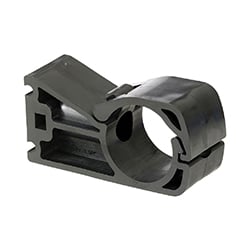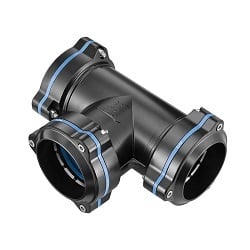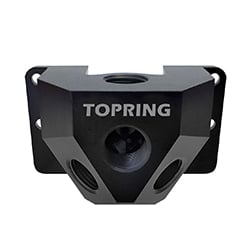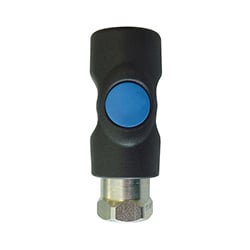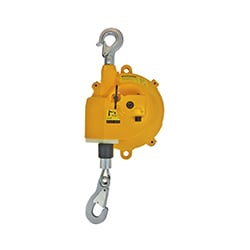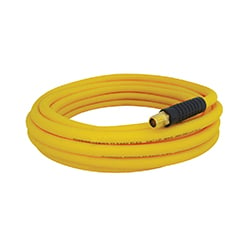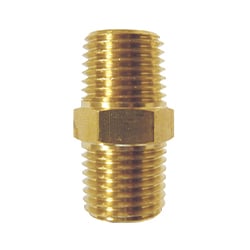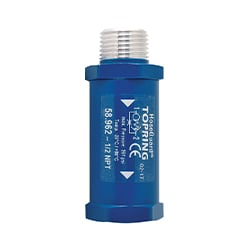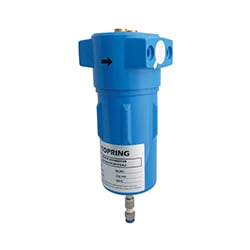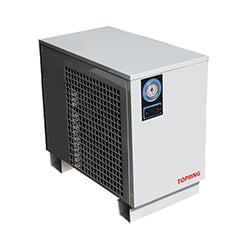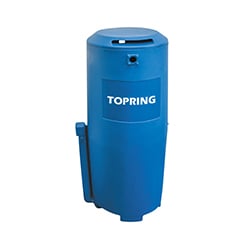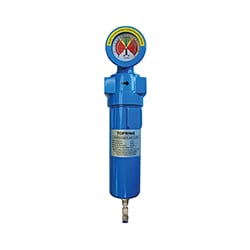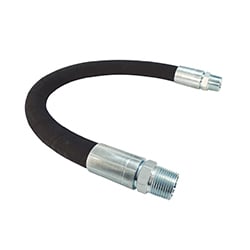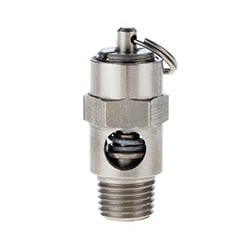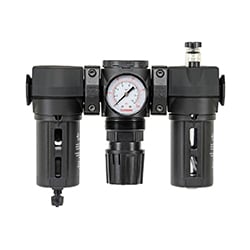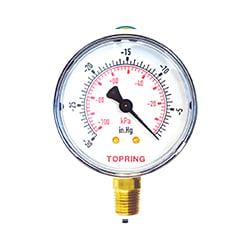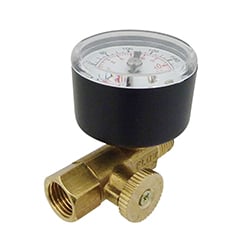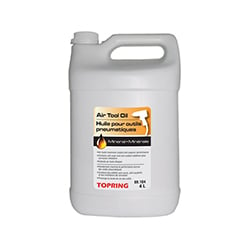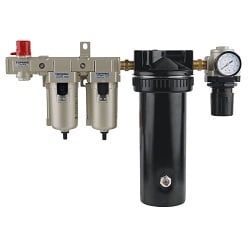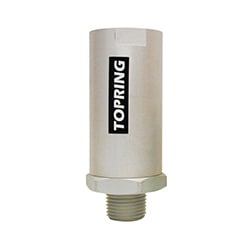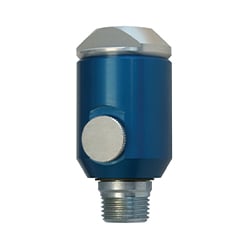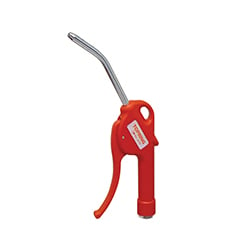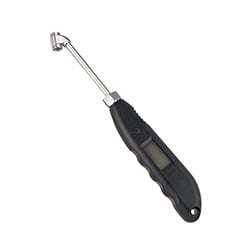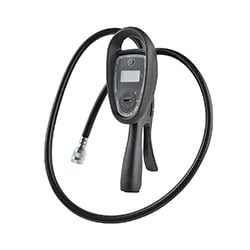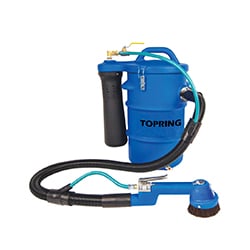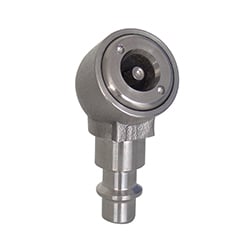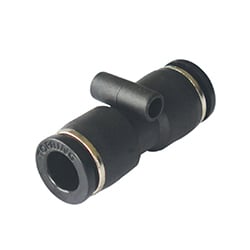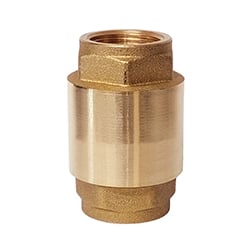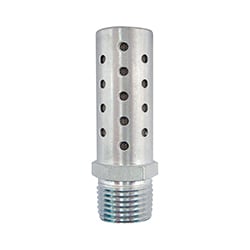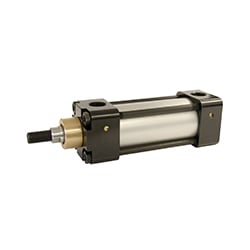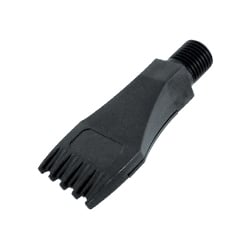We always wait until the last moment to do things... I would even say that if it is good advice for others, it is a little different when you have to apply all these beautiful ideas yourself... This is the case, for example, for air networks! We are always waiting to react until we are no longer be able to withstand pressure drops, the whistling of leaks or to have to choose between this or that work to "share" the air!!!
That said, it's never too late to get it right. When you decide, you must first take the time to think seriously and to pose the problem well. It is very important to list all the needs and constraints related to the use of the workshop. Indeed, the design of the general scheme of the air line will totally depend on the activity and the work methods. But well designed, the network will make it possible to correct the problems of the past and to respond in advance to those of the future. Here we will try to identify the main types of networks and comment on their advantages or disadvantages.
We can globally count five main principles of schemes, but I would like to say that these systems are basic and that we must always know how to adapt to circumstances.
The 5 main configurations of compressed air networks
1. The linear air system
It is a bad start because it is the very example of what not to do! This network consists of carrying out a simple linear air installation with two ends: an entrance and an end. This is usually what has been done in the past in workshops and has generated so many problems of pressure drops or other air shortages. The main concern lies in the fact that, delivered at one end, the compressed air will be consumed as we advance on the line. The more we advance, the less air will remain available. If we can correctly use a tool at the beginning of the network (that is to say, near the tank) it is certain that the further we go from the start, the more our tool will be underpowered, the upstream machines having consumed everything in passing... To properly represent the problem, imagine a water pipe on which we would have positioned taps. The first of them would probably be well fed, but then the last would only represent a drip, all the water having been evacuated by the previous taps! On the other hand, it can also happen that the line is very long. In this case, the phenomenon is aggravated by the friction of the air against the walls of the endless path (not always straight). This friction creates turbulence in the network, aggravating the loss of flow and pressure. We can therefore say that this type of network is really to be avoided! It is important to add that a minimum slope of 2% should be imposed in this case as to allow condensation from moisture to flow to the low points at the end of the line instead of finding it in each descent.
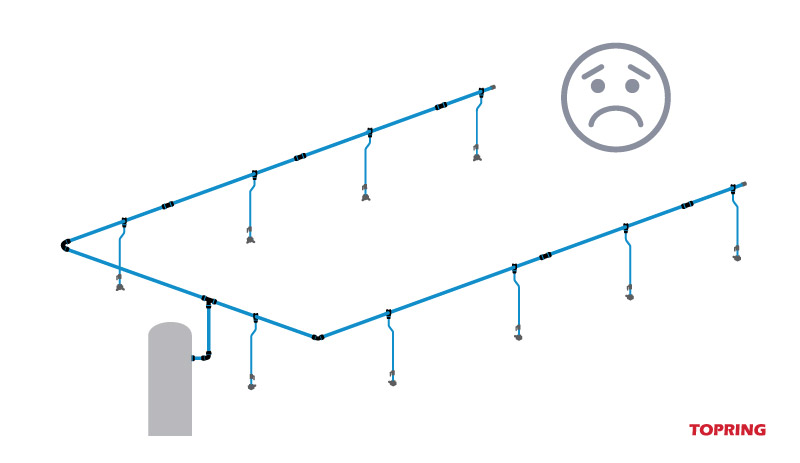
2. The antenna air system
Here is a drawing of an air line that will allow, under certain conditions, to already work much better! Indeed, this type of installation is based on the idea of an oversized central artery that will serve on both sides, smaller branches supplying the air descents. This plan works even better when a second tank is installed at the very end of the central pipe. We often talk about a "buffer" tank. It allows air to arrive faster regardless of the location of the drawdown point especially in case of sudden large consumption (pneumatic nail gun, etc.). On the other hand, each starting branch can be equipped with a shut-off valve that will offer the advantage of being able to isolate it from the rest of the network. We will particularly appreciate this "little extra" for example, during maintenance work, or during a temporary shutdown of part of the workshop (and remember that when there is no more air, there is no leak!). Finally, in some cases, each of the branches can receive an air treatment appropriate to its activity (dry and filtered air for a section dedicated to painting for example...). Of course, the advantages of this linear design will only be valid if the central tube is large enough in diameter to supply all the branches. On the purge side, it will be wise to install condensation drainage points on each tank in low points (a 2% slope on the main artery is recommended as well as on each branch) and at any strategic point of the network. One could compare this scheme to a set of roads that would connect the cities to a large central highway crossing the country.
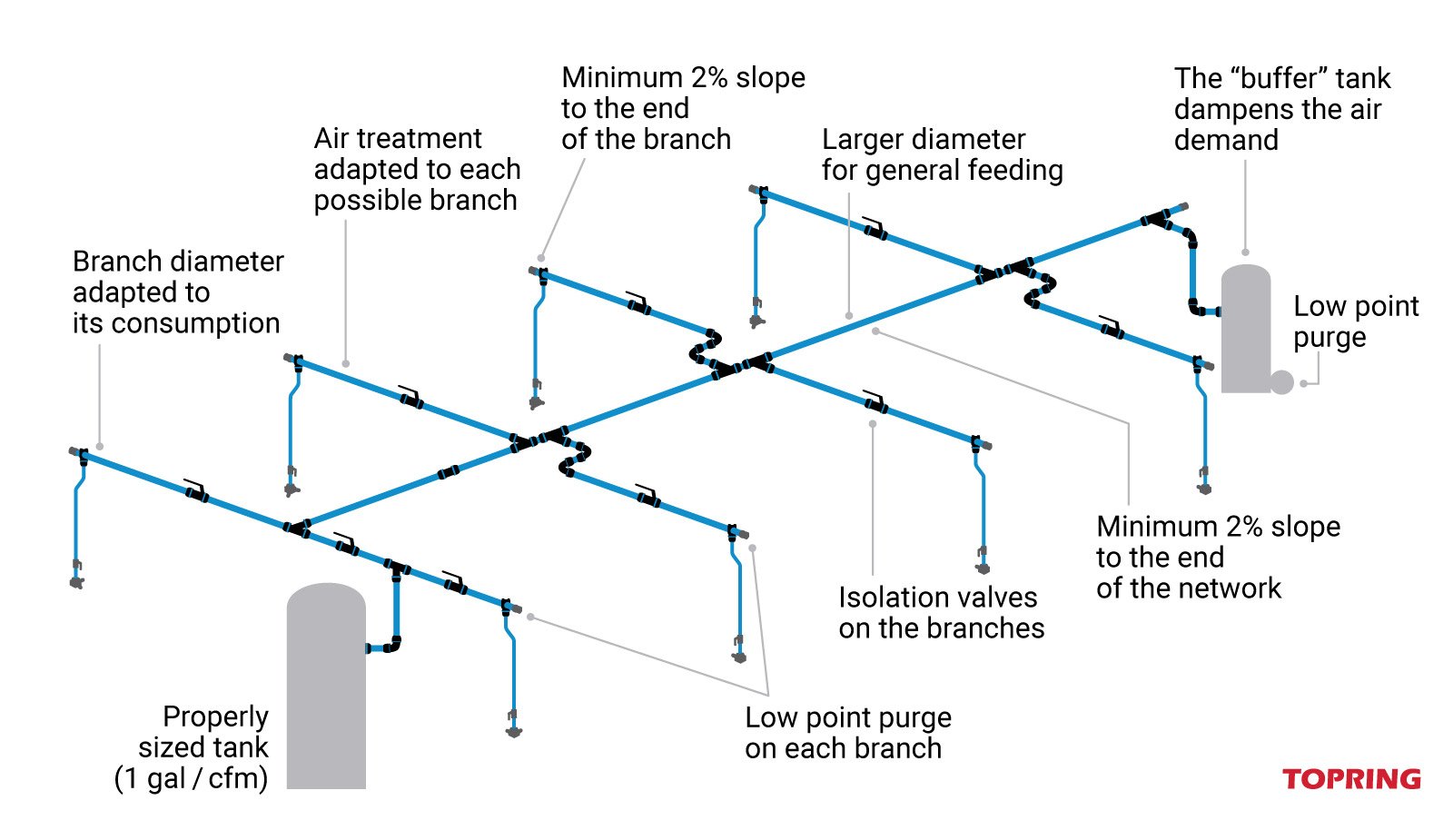
3. The closed loop air system
It is surely the most famous and simple type of efficient networks! It has many advantages, starting with a uniform distribution of air flow and an equal distribution of pressure at all points. In this configuration, everyone can work at the same time which is the basis of a good network. Too often we have seen the painter come out of his cabin furious when a colleague suddenly started using a tool that requires a lot of air (SCFM)… In these systems it is strongly recommended to install several block valves around the line. If necessary, these valves will allow a portion of the loop to be momentarily isolated for maintenance, while allowing the other workstations to be powered. In terms of cost, looping avoids investing in oversized tubes. It must be added that each descent, or whatever it may be, can always be powered by one side and/or the other of the loop. Purge points can be judiciously installed on the perimeter of the network which can remain horizontal. In fact, we could compare this type of installation to the ring road of a large city that facilitates road traffic by allowing cars to go from North to South quickly and without having to cross the city center!
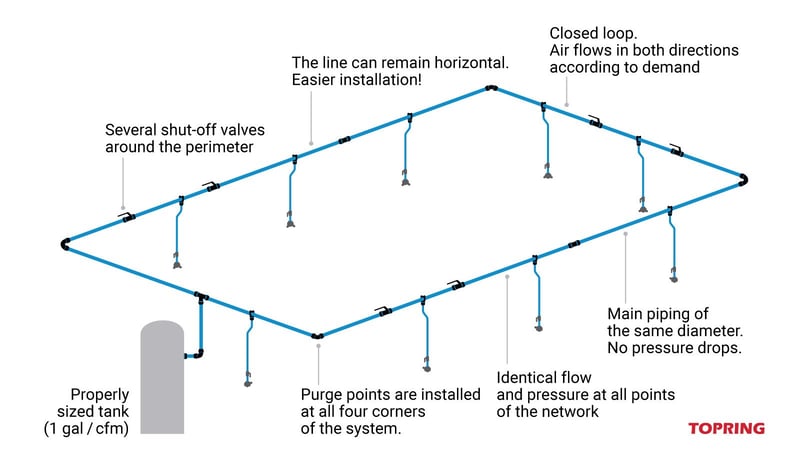
4. The satellite air system
This formula is rather complex but can be very effective in some cases. The principle is based on a compromise between the antenna network and the looped network. It is to be understood that this organization is intended mainly for large companies where one can work in several workshops. Here, a large central line distributes the air in as many smaller looped networks as necessary (each workshop). In addition to the advantages of the two previous systems mentioned, it is possible to close some unused areas or at least to open them only on demand. This will facilitate maintenance or limit any air leaks during opening hours... Of course, the system will work better if you add a tank at the head of the line and a second at the end of the main artery. On this system it is possible to condition the air of each workshop independently and according to the needs of the work. This offers the advantage of treating the air only as needed, and therefore equipping itself with better proportioned tools, and therefore cheaper equipment.
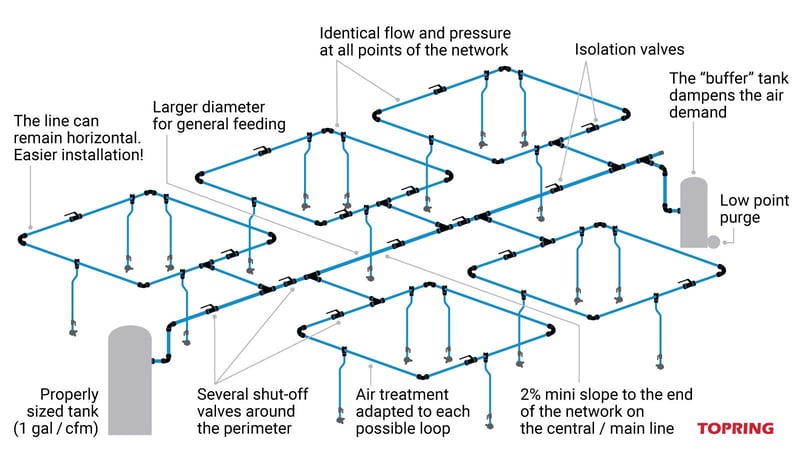
5. The gridded air system
This last solution is perhaps the most elaborate... In this case, we start from a looped network with all the advantages described above. The "gridded" system simply optimizes network performance. By dividing the general loop with "secondary" lines we will allow an even better supply of compressed air at the point of use. A bit like a main street, well equipped with main and secondary roads that can be good shortcuts to get from point A to point B! Here pressure and flow are at the rendezvous everywhere! From the closest to the farthest! Be careful not to forget to install purges, essential for the evacuation of water at strategic locations around the perimeter of the system, as well as shut-off valves (or quarter turn valves) on each primary or secondary portion. Here again it is not necessary to oversize the pipes, the multitude of possible paths offering the network a very large flow capacity. It should be noted that the distribution of compressed air can also be done on the central pipes of the grid, thus allowing a supply of air to the center of the workshop.
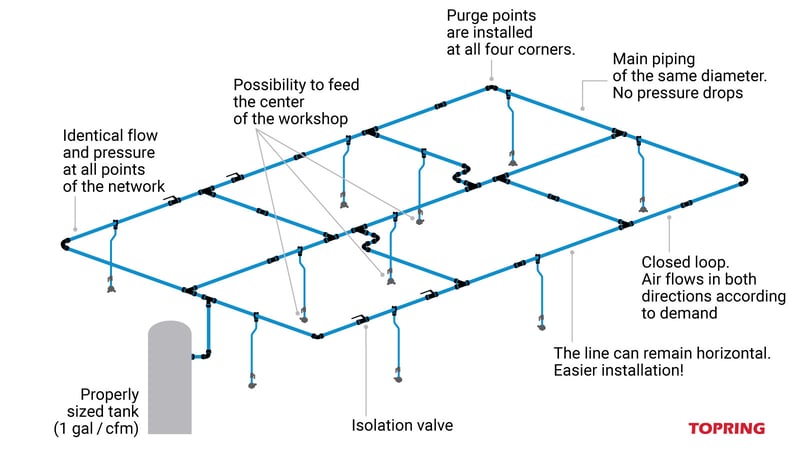
In conclusion
You have understood that the design of an air network is not automatic! It can be said that each case is as different as the next. When you decide to take action, the best idea is to consult a specialist who will analyze your work habits and needs. It is only by sharing this information with them that they will then be able to offer you the best formula (always the best... at the best price!). Topring is at your disposal and can work with you on the customized design of the installation you need (general diagram, calculation of sections, type of piping etc.). Thus, you will solve your problems which, very quickly, will become only sad memories.


